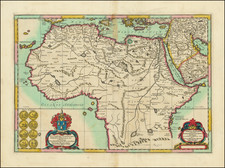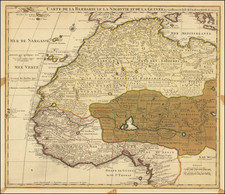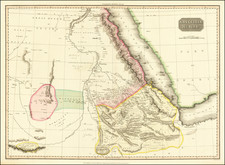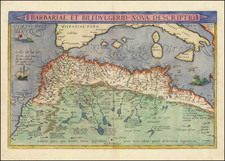An Early English Colony in Africa - The Proto-Gibraltar.
Interesting engraved bird's-eye view of the English colony of Tangier by R. White for John Ogilby.
This view is based on a larger one by Hollar after Jonas Moore.
We previously sold a manuscript of the colony, which can be seen here: www.raremaps.com/gallery/detail/61976
This was one of the new plates engraved for Ogilby's Africa, and is consequently surprisingly rare.
English Tangier
Tangier and Bombay were part of the dowry of Charles II’s Portuguese queen, Catherine of Braganza. The marriage contract was signed in June 1661, when Tangier seemed much the greater prize; Bombay in comparison was considered too distant. Tangier was turned into a massive, and very expensive, fortress at the entrance to the Mediterranean, more than fifty years before the English took control of Gibraltar in 1713. The colony was supposed to help suppress Barbary pirates, ward off foreign powers, and generally project English power into the Mediterranean.
The Tangier Colony became a major focus of English geopolitics (and internal politics) in the latter part of the seventeenth century, culminating with its abandonment and destruction in 1683 (elaborated below). The Tangier episode was an important experiment that yielded vital lessons for English imperialism in its early phase, particularly with respect to Africa and Gibraltar.
The abandonment and leveling of English Tangier
A 1676 survey of Tangier showed that there were 2,225 inhabitants of the colony, of whom fifty were army officers, 1,231 of other ranks, with 302 army wives and children. Parliament was concerned that the garrison was costing a hefty £140,000 a year to maintain. The King's frequent requests for more troops for the garrison raised suspicions that a standing army was being retained in Tangier to ensure a Catholic succession and absolute monarchy. In 1680 Parliament told the King that it would only grant supplies if he assented to a Bill of Exclusion to disinherit the Duke of York. The King refused to sacrifice his brother's right of succession to save Tangier.
In 1683, George Legge, Lord Dartmouth, went to Tangier in the company of naval official and diarist Samuel Pepys. In August of that year, Dartmouth, as Admiral of the Fleet and governor and captain general of Tangier, sailed from Plymouth. Pepys, as an observer, wrote an account of the expedition, which had a clandestine purpose. Dartmouth carried secret orders from Charles II to abandon Tangier. Dartmouth was to level the fortifications, destroy the harbor, and evacuate the troops.
Once in Tangier, Lord Dartmouth had several concerns. One was the evacuation of sick soldiers and their families and possessions. 114 invalid soldiers and 104 women and children sailed in October in the ships Unity and Diamond, arriving in England in December. Dartmouth was also eager to free English sailors held captive in North Africa. He negotiated the release of nearly forty men, including several officers, some of whom had spent ten years in the hands of the Moroccans.
Dartmouth’s final task was to blow up the English fortifications, leaving nothing for Moroccans or other powers who might follow. This took a considerable amount of work by the soldiers still stationed in the colony. They demolished the harbor wall and fortress buildings in the early weeks of 1684. As a final measure, they studded the walls of the fort with mines, to be blown as the last troops left the garrison. The official evacuation took place on February 5, 1684, with all troops free of the area by March.
It is likely that Phillips began this plan while in Tangier, although he may have also drafted or corrected it upon return to England. It was then needed by officials, perhaps to prove the thoroughness of the destruction. Prior to the final detonation of the mines, there had been much discussion about the efficacy and placing of the mines, and Phillips may have been trying to prove that he and his colleagues had done a systematic job.
Not all the residents of Tangier returned to England. Some of the departing soldiers were rewarded with large land grants in the newly acquired province of New York. Thomas Dongan, the 2nd Earl of Limerick and a former lieutenant-governor of Tangier, became New York provincial governor. William "Tangier" Smith, the last mayor of Tangier, obtained fifty miles of Atlantic oceanfront property on Long Island.
John Ogilby (1600-1676) was an English geographer and publisher, one of the most prominent of the seventeenth century. Little is known of his early life but by 1619 he was apprenticed to John Draper, a dancing-master in London. He worked as a dancing-master, courtier, and theater owner form 1620-1641. From 1649 he worked as a poet, translator, and publisher of classical texts. It is only in the last decade of his life that he entered into geography.
In 1649, Ogilby published his first translation, of Virgil, and continued to put out translations in the 1650s and 1660s. In March 1661 he was reconfirmed as master of revels in Ireland and appointed master of the king’s imprimeries, or king’s printer. From 1662 to 1665 he was in Ireland, where he most likely met Robert Boyle. He returned to London only to lose much of his printing stock in the Great Fire of 1666. Post-fire, he became assistant surveyor to the city, where he met Robert Hooke and Christopher Wren.
In 1669, Ogilby published Embassy to China. At the same time, he planned to release atlases that would cover the entire world. These atlases would be funded via subscriptions, advertisements, and lotteries—all common practice at the time, especially for expensive multi-volume works. He released Africa and Atlas Japannensis in 1670, America in 1671 and Atlas Chinensis in 1671, and Asia in 1673. Ogilby compiled the works based on materials produced by others and they reflect a growing interest in the wider world within England.
In 1671, while producing the atlases, Ogilby secured another royal title, that of his Majesty’s cosmographer. He used this title when publishing Britannia in 1675, his best-known work. The Britannia is best described as a road atlas; it shows 2519 miles of road in 100 strip maps. This technique would be widely adopted in the subsequent century. His method of measuring with a waywiser, a large wheel, also helped to standardize the distance of the English mile at 1760 yards. The Britannia was a major achievement in early English cartography and was republished in 1698, 1719, and 1720.













![(North Africa) La Barbarie et l'Egypte [on sheet with] Sein de Carthage [on sheet with] Aegypte](https://storage.googleapis.com/raremaps/img/small/85149.jpg)
![Africae Propriae Tabula In qua, Punica regna uides; Tyrios, et Agenoris urbem … 1590 [shows Malta]](https://storage.googleapis.com/raremaps/img/small/84017.jpg)